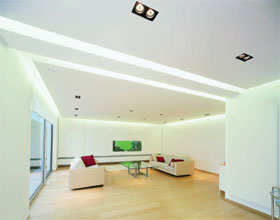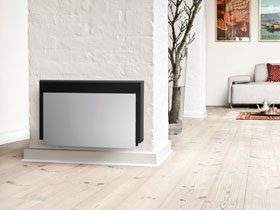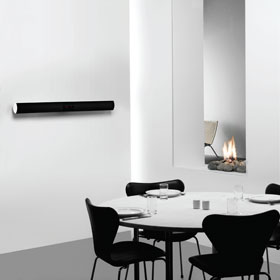Adding the latest technologies to a stylish home can end up cluttering a carefully designed room. However, Sharon Flaherty finds that interior designers are rising to the challenge, producing solutions that integrate technology and design without compromising on space or luxury.
Multimedia systems, with plasma screens, home cinemas and sound systems, can spoil a stylish home. However, there are ways to bring cutting-edge gadgets into your house while maintaining a particular look or colour scheme.
‘We have seen so many advances in technology
that you can now have the best multimedia systems without worrying about space, as they can be hidden,’ says Annabelle Filer who, with her husband Graham Cox, owns London-based interior design business Surfaces Covering Interiors (SCIN).
A good example is the BeoLiving suite designed by Bang & Olufsen, professionals in creating integrated multimedia interior solutions.
The suite is a fully integrated product with a 50in high-definition plasma TV screen that can pivot 90º, a drop-down projector and a 110in projection screen. The sound system features four loudspeakers and a centre speaker to enhance the digital home cinema experience while the
lighting is controlled remotely via a Lutron Homeworks system.
One technological advance that will help designers save space in high-tech homes is a TV
currently being developed by Bang & Olufsen that can be rotated 180º. This will work perfectl
in large open-plan spaces, as it can be viewed from either side. The pivoting flat screen also means it can be recessed and then brought into
view when in use.
‘We just don’t see barriers in what we do,’ Filer
insists. After setting up their first architectural practice in 1989, the couple watched it go from strength to strength until their passion for experimenting with interior surfaces took over and the concept of SCIN was born. They have completed around 800 projects in the last few
years, including some of the shops in London’s
Waterloo Station.
Filer says SCIN is like a good recipe book:
‘There are ingredients and ideas for beginners,
and more complex ingredients and ideas for the
more experienced.’
Renowned for their innovative ideas and use of materials, Filer and Cox believe that incorporating luxury technologies and interior design need not be a problem, and can actually produce some amazing effects.
Sound solutions
A great way to achieve good sound quality without
cluttering a room is to use stretch ceilings that enhance acoustics without affecting the room’s style.
Companies specialising in ceiling design, such as Barrisol and Inscape, stretch beautiful materials right across the ceiling to ‘tune’ the room and add to the overall design scheme. The material absorbs and manages the flow of sound through the room.
Another innovative solution utilises recycled and recyclable 3D sculptural acoustic tiles, which appeal to the environmentally conscious. The speaker system can be installed behind the walls
to create a seamless environment while the tiles
enhance the acoustics by deadening the sound.
In addition, the tiles, made by Re-Modern, can be designed and rotated to suit various colour schemes and looks.
Multimedia system companies are also working on the next generation of TVs and home cinema systems, aiming to produce flatter and more flexible screens, and better image quality. For example, Philips has started producing organic light emitting diodes (OLEDs), thin-film light-emitting diodes in which the emissive layer is an organic compound.
OLEDs in the form of square strips can be planted into glass made from bioluminescence from natural organisms in the sea, which means the lights can be placed in curved glass. Apart from saving space and enhancing the lighting in the room, OLEDs are much cheaper to produce than traditional LCDs and require less power.
Technological centrepiece
For the last 20 years, interior designers have been battling with the television and othe technologies in an attempt to hide, remove or disguise them. For some design schemes this is essential, but while technology can be used to save space and help create the perfect interior feel to your home behind the scenes, it can also become the design itself.

Some brands, such as Bang & Olufsen, make such beautiful products that the focus of a room can be the technology, saving on design features by combining aesthetics with practicality. There is no need for decorative furniture when practical furniture now looks so good.
Take the Bang & Olufsen Beovision 7, which combines the role of television and design feature. It allows a room’s focus to be aimed easily in one direction without overpowering everything around it. Where a painting might have provided the central focus of a room in the past, there is no reason why a really well designed piece of technology cannot do so now. |
|

Kitchen think
Technology has become an essential part of any new kitchen, which is understandable as a lot of time is spent here. A fridge, which is also a screen, or an integrated flip-down monitor under the shelves, allows hardware to remain hidden while providing a range of functions, such as ordering food on the internet, checking your email, selecting a CD to play while cooking or looking up a recipe.
The intelligent kitchen concept can be taken even further with a fridge that registers what food is in it, warns you when something is off and can even order a new carton of milk.
All of this can be done in a way that improves the overall aesthetic of a kitchen. If you have a sharp, modern feel to your kitchen a large screen on the fridge would add to the mood. If you prefer a cosy traditional kitchen atmosphere, simply slip the
technology behind the panels.
Technology can also help us save space in the bathroom. Thermotiles are ideal for people who prefer their walls to be a source of warmth. A conductive paste is applied as a graphic image onto the tiles and conductors are placed between each tile, which heats the tiles. This can give a bathroom a cosy feel without interfering with the design.
Various patterns and graphics are available and they can be varied around the room.
Flexible space
Sometimes it does not matter how well planned
and perfectly decorated a room is, you might just want to make it a little bigger or wish it was a different shape so you can fit the dining room table in the sitting room for a change.
This is becoming more feasible with the growing popularity of flexible living. Built-in furniture, modular millwork and movable walls can all be fitted in such a way that the living spaces can be modified to fit the occasion or your whim.
Moving walls is easier to achieve in a purposebuilt new home, which is what LivingHomes specialises in; but these features can also be added to old homes to allow a bit of flexibility.
Green with envy
The world is becoming more ecologically aware,
and homeowners are no different. However, many people are not prepared to sacrifice the look of their homes to protect the environment.
Thankfully, technology is developing ways of limiting environmental impact without taking away the luxury feel.
A new wave of designers and architects, including LivingHomes, are applying technology to make houses greener, using everything from solargenerated solargenerated electricity and living roofs that channel and reuse water to under-floor heating that is more efficient than air heaters.
New paints, such as Benjamin Moore’s EcoSpec, are being produced that do not release harmful chemicals over time. This not only protects the environment, it is also better for your health.
For Filer, integrating new technology is far from restrictive. She believes it has opened up endless possibilities: ‘Materials that are traditionally used as flooring can be allowed to grow up walls. Raw silk, glass or thin slices of wood can be melted together. Anything can be achieved with any amount of space regardless of what else you have in the room. You really can do anything.’
For Filer and Cox, the only limit to successfully incorporating luxury technologies with interior design is the imagination.
Manipulating materials
Annabelle Filer and Graham Cox travel extensively to pick up what could be the next big thing in interior design. Some of the materials available include standard gold wallpaper from Russia and vinyl flooring. This may not sound spectacular, but putting them together with other materials can result in an unusual and unique scheme.
‘New advances in laser technology mean that virtually any material can be screen printed to create unusual designs, such as carpet-printed concrete tiles and Persian rugs printed on cowhides,’ explains Filer.
Another new technique involves using lasers to cut intricate patterns out of luxury materials.
Canadian company Qmaas uses this method to produce 3D images that catch the light and change as the observer moves around. This can create stunning effects, such as giant floating lilies, without wasting space.
Using the same technique, sandstone can be cut so finely that it can be wrapped around a balloon, producing curved forms that can be used to make beautiful lighting solutions and even baths.

|
|


|











